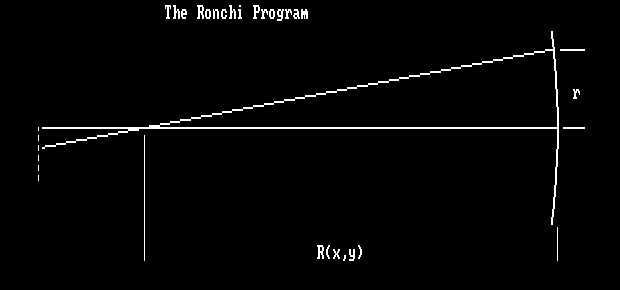

The Ronchi program runs from a nested loop. Each time the inner loop reaches a count that would place a pixel outside the edge of the mirror the inner loop is set to zero and the outer loop is incremented. The calculations proceed from the center of the mirror to the right and down. Reflections of the bottom right quadrant display in the top left quadrant, the top right quadrant, and the bottom left quadrant. At each increment, i, j, of the nested loops we must calculate whether we must set a pixel or not set a pixel.
The first thing to calculate is r, the distance from the center of the mirror to the point of interest on the mirror for this calculation. i and j are multiplied by a scalar that depends on the mirror diameter. We now have x and y which will be set to every point on the lower right quadrant of the mirror. Using the Pythagorean Theorem, r squared equals x squared plus y squared, we find r for the pixel of interest on the mirror. We divide r_squared by the radius_of_curvature of the center of the mirror. r_sq / R is the difference between the center radius_of_curvature and the radius_of_curvature(x, y) for the r(x,y) zone. Adding r_sq / R to the radius_of_curvature actually gives us a close approximation of the radius_of_curvature(x, y), see the Foot Note. We still need to know whether the ray from r(x, y) will pass through the Ronchi grating or be blocked.
Note: To make the program plot Ronchi-grams correctly we must actually add .5 * r_sq / R to the radius_of_curvature. Testing the program on mirrors shows this to be true.We were given the distance of the grating outside of the radius of curvature. Radius_of_curvature plus grating_position minus radius_of_curvature(x, y) equals the distance from the radius_of_curvature(x, y) to the grating = D. Connecting points r(0) on the mirror with r(x,y) on the mirror with the point where the ray from r(x,y) crosses the mirror axis we form a triangle. If you extend the line from r(x, y) through the point radius_of_curvature(x, y) on the mirror axis to the grating then draw a line to the mirror axis at the grating then to the radius_of_curvature(x, y) on the mirror axis a small triangle is formed. The small triangle is similar to the large triangle we drew earlier so the distance from the mirror axis to the ray at the grating is equal to r(x, y) * D / radius_of_curvature(x, y). We were given the frequency of the grating so we can now find whether or not the ray from r(x, y) will pass through the grating or not.
Running the program we find the bar that crosses the center of the mirror is twice too wide. To solve this problem the program does a preliminary calculation to find the width of the bar at the center of the mirror. The grating is then shifted the amount needed to make the center bar 1/2 a bar width wide. So now when the right quadrant is reflected into the left quadrant the center bar looks one bar width wide.
NOTES
The focal point of the curve at r(x,y) will not actually fall on the mirror axis. It will actually be near the focus of the mirror center but displaced further from the mirror and also off of the mirror axis. This inaccuracy in the Ronchi program will hardly make one pixel difference in the plotting.
The above description of the Ronchi program describes the DOS version written in Microsoft 'Quick C'. In the Java version the displayed mirror diameter is always 400 pixels. The calculations are done in centimeters. Data input is in inches, mm, miles, AU, light years or light waves. Data input is always converted to centimeters. Output to the screen is multiplied by a conversion factor of
mirror_diameter in cm to 400 pixels.In the Java version we found a better method to keep the center Ronchi bar from being twice too wide. We do a calculation to see if the pixel is to be set then a second calculation for a grating of twice the frequency then use an 'exclusive OR' of the two to make the plot. This eliminates the preliminary calculation used to shift the grating in the DOS version of the program.